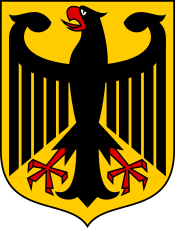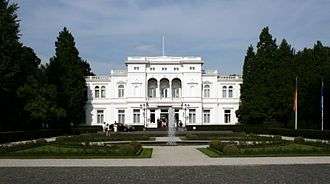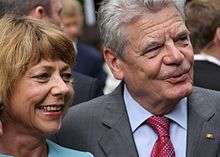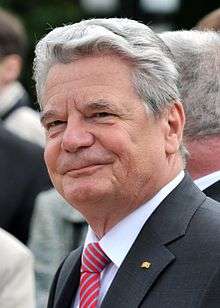President of Germany
| Federal President of the Federal Republic of Germany
Bundespräsident der Bundesrepublik Deutschland | |
|---|---|
|
| |
| Style |
His/Her Excellency (in international relations only) |
| Residence |
Schloss Bellevue (Berlin) Villa Hammerschmidt (Bonn) |
| Appointer | Federal Convention |
| Term length |
Five years Renewable once, consecutively |
| Constituting instrument | Basic Law for the Federal Republic of Germany |
| Precursor | The Reichspräsident |
| Formation | 13 September 1949 |
| First holder | Theodor Heuss |
| Website |
www |
 |
| This article is part of a series on the politics and government of Germany |
|
Constitution ("Fundamental Law Code") |
|
| Foreign relations |
The President of Germany, officially the President of the Federal Republic of Germany (German: Bundespräsident der Bundesrepublik Deutschland),[1] is the head of state of Germany.
Germany has a parliamentary system of government in which the Federal Chancellor is the nation's leading political figure and de facto chief executive. However, the President has a role which, while not an executive post, is more than ceremonial. Presidents have extensive discretion regarding the way they exercise their official duties.[2] The Federal President gives direction to general political and societal debates and has some important "reserve powers" in case of political instability (such as those provided for by Article 81 of the Basic Law).[3] Under Article 59 (1) of the Basic Law (German Constitution), the Federal President represents the Federal Republic of Germany in matters of international law, concludes treaties with foreign states on its behalf and accredits diplomats.[4] Furthermore, all federal laws must be signed by the President before they can come into effect; however, he or she can only veto a law that he/she believes to violate the constitution.
The Federal President, by his or her actions and public appearances, represents the state itself, its existence, its legitimacy, and unity. The President's office involves an integrative role and the control function of upholding the law and the constitution. It is a matter of political tradition – not legal restrictions – that the Federal President generally does not comment routinely on issues in the news, particularly when there is some controversy among the political parties.[5] This distance from day-to-day politics and daily governmental issues allows the Federal President to be a source of clarification, to influence public debate, to voice criticism, offer suggestions and make proposals. In order to exercise this power, he/she traditionally acts above party politics.[6]
The current officeholder is Joachim Gauck who was elected on 18 March 2012.
Selection
The president is elected by secret ballot, without debate, for a term of five years by the Federal Convention which mirrors the aggregated majority situation of the Bundestag and the parliaments of the 16 German federal states. The convention consists of all Bundestag members as well as an equal number of delegates chosen by the legislatures of the Länder (states). The delegates of each Land to the Federal Convention are elected by the members of the state legislature under a form of proportional representation. However it is not required that Land delegates themselves be members of a legislature; often prominent citizens are chosen.
In total, the Federal Convention numbers more than one thousand members. The German constitution, the Basic Law, requires that it be convened no later than thirty days before the expiration of the sitting president's term. The body is convened and chaired by the President of the German Bundestag. From 1979 to 2009, all these conventions have been held on 23 May, the date of the foundation of the Federal Republic in 1949. However, the two latest elections were held on different dates after the incumbent presidents stepped down before the end of their terms since they had to be held within 30 days of Horst Köhler's and Christian Wulff's resignations in 2010 and 2012 respectively.
In the first two rounds of the election process, the Federal Convention attempts to elect a president by an absolute majority of votes cast. If, after two votes, no single candidate has received this level of support, in the third and final vote the candidate endorsed by a plurality of votes cast is elected.
The process of electing the president is usually determined by party politics. Usually, the candidate of the majority party or coalition in the Bundestag is considered to be the likely winner. However, if the opposition has turned in a strong showing in state elections, it can potentially have enough support to defeat the government's candidate. For this reason, presidential elections can indicate the result of an upcoming general election. According to a long-standing adage in German politics, "if you can create a president, you can form a government."
Qualifications
The office of president is open to all Germans who are entitled to vote in Bundestag elections and have reached the age of 40, but no one may serve more than two consecutive five-year terms. The president must not be a member of the federal government or of a legislature at either the federal or state level.
Oath
On taking office the president must take the following oath, stipulated by Article 56 of the Basic Law, before the assembled members of the Bundestag and Bundesrat (however he or she is permitted to omit the religious references if so desired):
I swear that I will dedicate my efforts to the well-being of the German people, enhance their benefits, avert harm from them, uphold and defend the Constitution and the statutes of the Federation, fulfil my duties conscientiously, and do justice to all. (So help me God.)[7]
Duties and functions


The Federal President is involved in the formation of the Federal Government and remains in close cooperation with it. Basically the President is free to act on his own accord. However, according to Article 58 of the German constitution, most orders and directives of the Federal President require the countersignature of the Federal Chancellor or the corresponding Federal Minister. This rule ensures the coherence of government action. Therefore, the Federal President also receives the Federal Chancellor regularly for talks on current policy issues. He or she also holds talks with individual Federal Ministers and other senior officials at his own discretion. The "Head of the Office of the Federal President" represents the President in the meetings of the Federal Cabinet and reports back to the Federal President.[8]
The Federal President's most prominent duties include:[8]
- Proposing the Federal Chancellor to the Bundestag
- Appointing and dismissing the Federal Chancellor and Federal Ministers
- Dissolving the Bundestag under certain circumstances
- Convening the lower house of the federal parliament (Bundestag) according to article 39 of the constitution
- Signing and promulgating laws
- Appointing and dismissing federal judges, federal civil servants, and commissioned and non-commissioned officers of the Armed Forces
- Exercising the power to pardon individual offenders on behalf of the Federation
- Awarding honours on behalf of the Federation
- Representing Germany at home and abroad
Appointment of the Federal Government
The Federal President proposes an individual as Federal Chancellor and then, provided he or she is subsequently elected by the Bundestag, appoints him or her to the office. However, the Bundestag is free to disregard the president's proposal and elect another individual to the post, whom the president is then obliged to appoint. The president appoints and dismisses the remaining members of the Federal Government "upon the proposal of the Chancellor." The president can dismiss the Chancellor, but only in the event that the Bundestag passes a Constructive Vote of No Confidence.[9] If this occurs, the president must dismiss the chancellor and appoint the successor requested by the Bundestag.[9]
Other appointments
The president appoints federal judges, federal civil servants and military officers. All such appointments require the counter-signature of either the chancellor or the relevant cabinet minister.[10]
Dissolution of the Bundestag
In the event that the Bundestag elects an individual for the office of chancellor by a plurality of votes, rather than a majority, the president can, at his or her discretion, either appoint that individual as chancellor or dissolve the Bundestag, triggering a new election. In the event that a vote of confidence is defeated in the Bundestag, and the incumbent chancellor proposes a dissolution, the president may, at his discretion, dissolve the body within 21 days. As of 2010, this power has only been applied three times in the history of the Federal Republic. In all three occurrences it is doubtful whether the motives for that dissolution were in accordance with the constitution's intentions. Each time the incumbent chancellor called for the vote of confidence with the stated intention of being defeated, in order to be able to call for new elections before the end of their regular term, as the Basic Law does not give the Bundestag a right to dissolve itself. The most recent occurrence was on 1 July 2005, when Chancellor Gerhard Schröder asked for a vote of confidence, which was defeated.[11]
Promulgation of the law
All federal laws must, after counter-signature, be signed by the president before they can come into effect.[12] Upon signing, the president has to check if the law was passed according to the order mandated by the constitution and/or if the content of the law is constitutional. If not, he or she has the right (and, some argue, the duty) to refuse to sign the law. This has happened rather rarely.
Foreign relations
The president represents Germany in the World (Art. 59 Basic Law), holds foreign visits and receives foreign dignitaries. He or she also concludes treaties with foreign nations (which do not come into effect until affirmed by the Bundestag), accredits German diplomats and receives the letters of accreditation of foreign diplomats.
Pardons and honours
According to Article 60 (2) of the German Constitution the Federal President exercises the power to pardon. This means he "has the authority to revoke or commute penal or disciplinary sentences in individual cases. The Federal President cannot, however, issue an amnesty waiving or commuting sentences for a whole category of offences. That requires a law enacted by the German Bundestag in conjunction with the Bundesrat. Due to the federal structure of Germany the Federal President is only responsible for dealing with certain criminal matters (e.g. espionage and terrorism) and disciplinary proceedings against federal civil servants, federal judges and soldiers".[13]
State of legislational emergency
In the event of a national crisis, the Basic Law designates the president as a mediator. If the Bundestag rejects a motion of confidence, but neither a new chancellor is elected nor the Bundestag is dissolved, the president may, by request of the cabinet, declare a "legislative state of emergency", which is quite different from a conventional state of emergency: If it is declared, during a limited period of time, bills proposed by the cabinet and designated as "urgent", but rejected by the Bundestag, become law nonetheless, if the Bundesrat does pass them. But the legislative state of emergency does not suspend basic human rights nor does it grant the executive branch any exceptional power. Such an emergency has never been declared.
Politics and influence

Though candidates are usually selected by a political party or parties, the president nonetheless is traditionally expected to refrain from being an active member of any party after assuming office. Every president to date has let his or her party membership rest dormant during his term of office. Presidents have, however, spoken publicly about their personal views on political matters. The very fact that a president is expected to remain above politics usually means that when he does speak out on an issue, it is considered to be of great importance. In some cases, a presidential speech has dominated German political debate for a year or more.[14]
Reserve powers
According to article 81 of the German constitution the president can declare an "Legislation Emergency" and allow the federal government and the Bundesrat to enact laws without the approval of the Bundestag (lower house of parliament). He also has important decisive power regarding the appointment of a chancellor who was elected by a relative majority only, or the dissolution of the Bundestag under certain circumstances.
It is also theoretically possible, albeit a drastic step which has not happened since 1945, that the president refuses to sign legislation merely because he disagrees with its content, thus vetoing it, or refuse to approve a cabinet appointment.[15] In all cases in which a bill was not signed by the Federal President, all presidents have claimed that the bill in question was manifestly unconstitutional. For example, in the autumn of 2006, President Köhler did so twice within three months. Also, in some cases, a president has signed a law while asking that the political parties refer the case to the Federal Constitutional Court in order to test the law's constitutionality.
Succession
The Basic Law did not create an office of vice president. If the office of president falls vacant, the President of the Bundesrat (currently Malu Dreyer, the Minister President of Rhineland-Palatinate) temporarily assumes the powers of the president until a successor is elected without assuming the office of president as such. While doing so, he or she does not continue to exercise the role of chair of the Bundesrat.[16] If the president dies, resigns or is otherwise removed from office, a successor is to be elected within thirty days. This process was triggered for the first time on May 31, 2010, when Horst Köhler resigned the office, as all his predecessors (with the exception of Heinrich Lübke, who announced in 1968 that he would resign the following year, his resignation taking effect after the regular election of his successor and just three months before the scheduled end of his term of office) had served their terms in full. Jens Böhrnsen, Mayor of Bremen and at the time President of the Bundesrat, assumed the powers and duties of head of state.[17] The same took place in 2012 after Christian Wulff resigned; then Horst Seehofer, Minister President of Bavaria, as President of the Bundesrat assumed the powers and duties of head of state.
Impeachment and removal
While in office the president enjoys immunity from prosecution and cannot be voted out of office or recalled. The only mechanism for removing the president is impeachment by the Bundestag or Bundesrat for willfully violating German law. Once the Bundestag impeaches the president, the Federal Constitutional Court is charged with determining if he or she is guilty of the offence. If the charge is sustained the court has the authority to remove the president from office.
Presidential office and symbols
_(6272414834).jpg)
Office
The Office of the Federal President is a supreme federal authority. It organizes the President's work, supports the Federal President in the performance of his duties as Head of State and coordinates his working relationships to other parts of the German government and administration. Its top official, who takes precedence over all other German state secretaries, is the Head of the Office of the Federal President. The office and its staff advises the Federal President, informs him of all developments in domestic and foreign affairs and carries out the instructions of the Federal President or forwards these to the corresponding ministry or authority.[18]
Residences
The official residence of the Federal President is Bellevue Palace in Berlin. The President's second official residence is the Hammerschmidt Villa in the former capital city of West Germany, Bonn.

Transportation
The Federal President's car is usually black, made in Germany and has the numberplate "0 – 1" with the presidential standard on the right wing of the car. The President also uses a VIP helicopter operated by the Federal Police and VIP aircraft (Bombardier Global 5000, Airbus A319CJ, Airbus A310 or A340) operated by the German Ministry of Defence. When the President is on board, the flight's callsign is "German Airforce 001".
Presidential standard

The standard of the President of Germany was adopted on 11 April 1921, and used in this design until 1933. A slightly modified version also existed from 1926, that was used in addition to the 1921 version. In 1933, these versions were both replaced by another modified version, that was used until 1935.
The Weimar-era presidential standard from 1921 was adopted again as presidential standard by a decision by President Theodor Heuss on 20 January 1950, when he also formally adopted other Weimar-era state symbols including the coat of arms. The eagle (Reichsadler, now called Bundesadler) in the design that was used in the coat of arms and presidential standard in the Weimar Republic and today was originally introduced by a decision by President Friedrich Ebert on 11 November 1919.
History
The modern day position of German President is significantly different from the Reich President of the Weimar Republic – a position which held considerable power and was regarded as a Supreme Government Executive.[19]
Weimar Republic
The position of President of Germany was first established by the Weimar Constitution, which was drafted in the aftermath of World War I and the abdication of Emperor Wilhelm II in 1918. In Germany the new head of state was called the Reichspräsident.
Friedrich Ebert (SPD) served as Germany's first president, followed by Paul von Hindenburg. The office effectively came to an end upon Hindenburg's death in 1934 and its powers merged with those of Chancellor. Adolf Hitler now ruled Germany as "Führer und Reichskanzler", combining his previous positions in party and government. The office however was not abolished and briefly revived at the end of the Second World War when Hitler appointed Grand Admiral Karl Dönitz as his successor as President of Germany. Dönitz agreed to the surrender to the Allies and was arrested a few days later.[20]
The Weimar Constitution created a semi-presidential system in which power was divided between the president, a cabinet and a parliament. The president enjoyed far greater power than the current president and had an active political role, rather than a largely ceremonial one. The influence of the president also increased greatly as a result of the instability of the Weimar period. The president had authority to appoint the Chancellor and could dismiss the entire cabinet at any time. However it was also necessary for the cabinet to enjoy the confidence of the Reichstag (parliament) because it could be removed by a vote of no confidence.[21] All bills had to receive the signature of the president to become law and, although he did not have an absolute veto on legislation, he could insist that a law be submitted for the approval of voters in a referendum. The president also had authority to dissolve the Reichstag, conduct foreign affairs, and command the armed forces. Article 48 of the constitution also provided the president sweeping powers in the event of a crisis. If there was a threat to "public order and security" he could legislate by decree and suspend civil rights.
The Weimar constitution provided that the president be directly elected and serve a seven-year term. The election involved a form of the two-round system. However the first president was elected by the National Assembly and subsequently only two direct presidential elections actually occurred. These were the election of Paul von Hindenburg in 1925 and his re-election in 1932.
The system created by the Weimar constitution led to a number of problems. In particular, the fact that the president could appoint the cabinet, while the Reichstag had only a power of dismissal, created a high cabinet turn-over as ministers were appointed by the president only to be dismissed by the Reichstag shortly afterwards. Eventually Hindenburg stopped trying to appoint cabinets that enjoyed the confidence of the Reichstag and ruled by means of three "presidential cabinets" (Präsidialkabinette). Hindenburg was also able to use his power of dissolution to by-pass the Reichstag. If the Reichstag threatened to censure his ministers or revoke one of his decrees he could simply dissolve the body and be able to govern without its interference until elections had been held. This led to eight Reichstag elections taking place in the 14 years of the Republic's existence; only one parliamentary term, that of 1920–1924, was completed without elections being held early.
German Democratic Republic (East Germany)
Socialist East Germany established the office of a head of state with the title of President of the Republic (German: Präsident der Republik) in 1949, but abandoned the office with the death of the first president, Wilhelm Pieck, in 1960 in favour of a collective head of state. All government positions of the East German socialist republic, including the presidency, were appointed by the ruling Socialist Unity Party of Germany.
Federal Republic of Germany (West Germany)
With the promulgation of the Grundgesetz in 1949, the office of President (in German: Bundespräsident) was created in West Germany. Partly due to the misuse of presidential powers in the Weimar Republic, the office's powers were significantly reduced. Not only is he indirectly elected, but most of the real power was transferred to the federal chancellor.
Because the reunification of Germany in 1990 was accomplished by the five East German states joining the Federal Republic, the Federal President became the President of all German states.
List of presidents
See also
References
- ↑ The official title within Germany is Bundespräsident, with der Bundesrepublik Deutschland being added in an international context; the official English title is President of the Federal Republic of Germany
Foreign Office of the Federal Republic of Germany (1990). German Institutions. Terminological Series issued by the Foreign Office of the Federal Republic of Germany. Volume 3. de Gruyter. p. 28. ISBN 0-89925-584-1. - ↑ German constitutional court: BVerfG, – 2 BvE 4/13–10 June 2014, No. 28
- ↑ "Basic Law for the Federal Republic of Germany". Gesetze-im-internet.de. Retrieved 2012-11-22.
- ↑ Website of the Federal President of Germany Retrieved 28 April 2014
- ↑ Official website of the Federal President of Germany: Constitutional basis Retrieved 29 April 2014
- ↑ Official Website of the Federal President of Germany Retrieved 28 April 2014
- ↑ Grundgesetz für die Bundesrepublik Deutschland. Article 56.
- 1 2 Official Website of the Federal President of Germany: Interaction between constitutional organs. Retrieved 29 April 2014
- 1 2 Grundgesetz für die Bundesrepublik Deutschland (in German). Article 67.
- ↑ Grundgesetz für die Bundesrepublik Deutschland (in German). Article 60.1.
- ↑ Grundgesetz für die Bundesrepublik Deutschland (in German). Articles 67 and 68.
- ↑ Grundgesetz für die Bundesrepublik Deutschland (in German). Article 82.
- ↑ The Federal President of Germany – Official Functions. Retrieved 29 April 2014
- ↑ "Das Amt des Bundespräsidenten und sein Prüfungsrecht" (in German). Bpb.de. Retrieved 2012-11-22.
- ↑ Heinrich Wilms: Staatsrecht I: Staatsorganisationsrecht unter Berücksichtigung der Föderalismusreform. Stuttgart 2007. pp. 201 ff. (German)
- ↑ "Geschäftsordnung des Bundesrates" [Rules of Procedure of the Bundesrat] (PDF). §7 (1). Retrieved 7 November 2016.
Die Vizepräsidenten vertreten den Präsidenten im Falle seiner Verhinderung oder bei vorzeitiger Beendigung seines Amtes nach Maßgabe ihrer Reihenfolge. Ein Fall der Verhinderung liegt auch vor, solange der Präsident des Bundesrates nach Artikel 57 des Grundgesetzes die Befugnisse des Bundespräsidenten wahrnimmt.
- ↑ "Interview zum Köhler-Rücktritt: "Das hat es noch nicht gegeben"". tagesschau.de. Retrieved 2012-11-22.
- ↑ Official website of the Federal President of Germany Retrieved 29 April 2014
- ↑ Zentner, Christian Ed; Bedürftig, Friedemann Ed (1985). Das große Lexikon des Dritten Reiches (in German). München: Südwest Verlag. p. 686. ISBN 3-517-00834-6.
- ↑ Reichgesetzblatt part I. Berlin: de:Bild:RGBL I 1934 S 0747.png. Reich Government. 1 August 1934. p. 747.
|first1=missing|last1=in Authors list (help); - ↑ "The Constitution of the German Federation of 11 August 1919". Retrieved 2007-07-16.
External links
| Wikimedia Commons has media related to Bundespräsident (Deutschland). |
